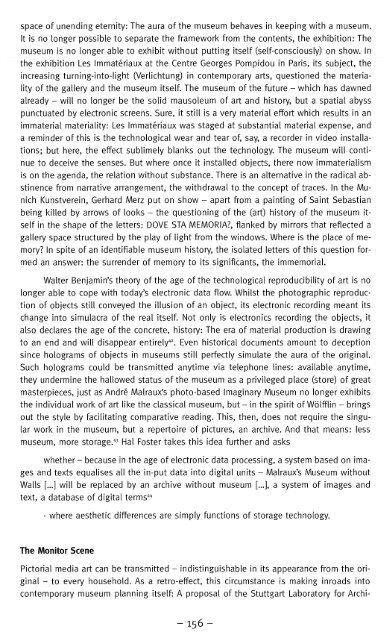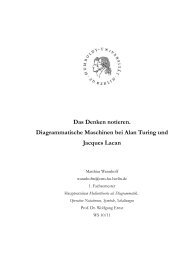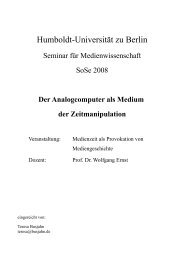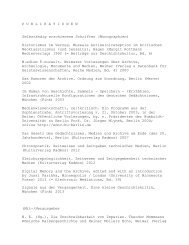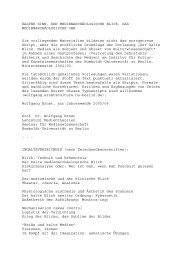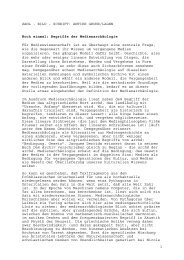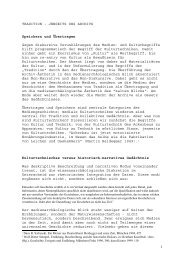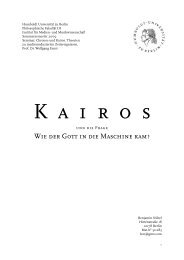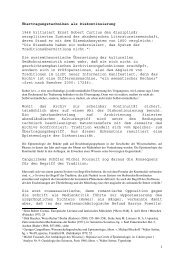Download - Medienwissenschaft
Download - Medienwissenschaft
Download - Medienwissenschaft
You also want an ePaper? Increase the reach of your titles
YUMPU automatically turns print PDFs into web optimized ePapers that Google loves.
space of unending eternity: The aura of the museum behaves in keeping with a museum.<br />
It is no longer possible to separate the framework from the contents, the exhibition: The<br />
museum is no longer able to exhibit without putting itself (self-consciously) on show. In<br />
the exhibition Les Immateriaux at the Centre Georges Pompidou in Paris, its subject, the<br />
increasing tuming-into-light (Verlichtung) in contemporary arts, questioned the materiality<br />
of the gallery and the museum itself. The museum of the future - which has dawned<br />
already - will no longer be the solid mausoleum of art and history, but a spatial abyss<br />
punctuated by electronic screens. Sure, it still is a very material effort which results in an<br />
immaterial materiality: Les Immateriaux was staged at substantial material expense, and<br />
a reminder of this is the technological wear and tear of, say, a recorder in video installations;<br />
but here, the effect sublimely blanks out the technology. The museum will continue<br />
to deceive the senses. But where once it installed objects, there now immaterialism<br />
is on the agenda, the relation without substance. There is an alternative in the radical abstinence<br />
from narrative arrangement, the withdrawal to the concept of traces. In the Munich<br />
Kunstverein, Gerhard Merz put on show - apart from a painting of Saint Sebastian<br />
being killed by arrows of looks - the questioning of the (art) history of the museum itself<br />
in the shape of the letters: DOVE STA MEMORIA?, flanked by mirrors that reflected a<br />
gallery space structured by the play of light from the windows. Where is the place of memory?<br />
In spite of an identifiable museum history, the isolated letters of this question formed<br />
an answer: the surrender of memory to its significants, the immemorial.<br />
Walter Benjamin's theory of the age of the technological reproducibility of art is no<br />
longer able to cope with today's electronic data flow. Whilst the photographic reproduction<br />
of objects still conveyed the illusion of an object, its electronic recording meant its<br />
change into simulacra of the real itself. Not only is electronics recording the objects, it<br />
also declares the age of the concrete, history: The era of material production is drawing<br />
to an end and will disappear entirely 42 . Even historical documents amount to deception<br />
since holograms of objects in museums still perfectly simulate the aura of the original.<br />
Such holograms could be transmitted anytime via telephone lines: available anytime,<br />
they undermine the hallowed status of the museum as a privileged place (store) of great<br />
masterpieces, just as Andre Malraux's photo-based Imaginary Museum no longer exhibits<br />
the individual work of art like the classical museum, but- in the spirit of Wölfflin - brings<br />
out the style by facilitating comparative reading. This, then, does not require the singular<br />
work in the museum, but a repertoire of pictures, an archive. And that means: less<br />
museum, more storage." 3 Hal Foster takes this idea further and asks<br />
whether-because in the age of electronic data processing, a system based on images<br />
and texts equalises all the in-put data into digital units - Malraux's Museum without<br />
Walls [...] will be replaced by an archive without museum [...], a system of images and<br />
text, a database of digital terms 44<br />
- where aesthetic differences are simply functions of storage technology.<br />
The Monitor Scene<br />
Pictorial media art can be transmitted - indistinguishable in its appearance from the original<br />
- to every household. As a retro-effect, this circumstance is making inroads into<br />
contemporary museum planning itself: A proposal of the Stuttgart Laboratory for Archi-<br />
- 156 -


